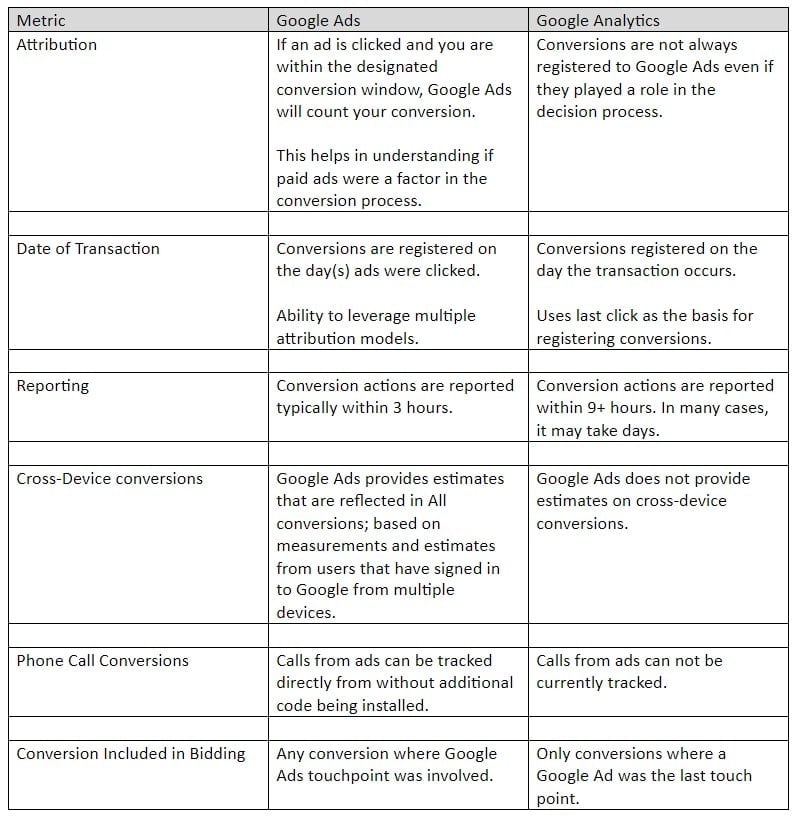You would think tracking conversions in Google Ads and Google Analytics would yield the same results. It usually doesn’t. The reasons for this conundrum are essential to understand as you manage your pay-per-click (PPC) advertising campaigns.
For the purpose of illustration, let’s use the following scenario to understand the different ways in which these two platforms track conversions:
- On Monday, Jane clicks on an ad and reviews information but does not complete a transaction or other conversion action.
- On Tuesday, Jane gets an email that says, “You left items in your cart; don’t forget to checkout!” She clicks the email link but does not complete her order.
- On Saturday, Jane goes directly to the website and finally finishes her order.
The path that Jane used to convert from visitor to customer for this example was Google Ads > Email > Direct.
Now for the difference in conversion attribution between the two platforms, Google Ads and Google Analytics.
Google Analytics: Jane’s purchase will be tracked based on the last click action and the date of the conversion. In this case, the last action was a direct visit to the website. Since Google Analytics leverages the last-click attribution model, the conversion action would be registered to the source “Direct” on Wednesday, the date the transaction occurred.
As you can see, the last-click attribution model does not always paint a complete picture, since Google Ads would receive no credit for assisting in the customer decision process. You would not know Google Ads played any role in the customer journey unless you went to the “Top Conversions Paths” tab by clicking on “Conversions” and then “Multi-Channel Funnels.”
Google Ads: On the other hand, Google Ads will attribute conversions based on the date the ad (or ads) were clicked. In Jane’s case, Google Ads would attribute a conversion action to a campaign, ad group, keyword, and ad on Monday, the day the ad was clicked. Google Ads would be given credit for the conversion so you would know that paid advertising did assist in the decision process.
To restate the core difference between the two:
- Google Analytics uses the last-click attribution model, which assigns all attribution for the conversion to the final channel on the day that the conversion took place;
- Google Ads counts every conversion that an ad played a role in, on the day of the ad click, regardless of which channel drove the final conversion.
Google Ads gives you the option to select from different attribution models to best fit your business goals. We typically leverage position-based or data-driven attribution, but the attribution model should be based on business requirements. To learn more about all six of the Google Ads Attribution models, read “6 Google Ads PPC Attribution Models, One to Rule Them All.”
Google Ads vs. Google Analytics Conversion Tracking Chart
The two platforms, Google Ads and Google Analytics, differ in other ways as well. The following chart will help you understand the finer points.
As with any endeavor, understanding what the metrics you’re measuring truly mean is critical to using them effectively to improve your business performance. And while having a conversion register with Google Ads is important for properly understanding the effectiveness of your PPC advertising, it is also a key component in Google Ads algorithms.

In general, the more data you provide Google, the better it is at understanding and serving ads to the right people. The trend is towards more automation so the more and better inputs that are provided, the better the chance for success. Google Ads conversion tracking provides those “better inputs.”
Google Analytics is a powerful measurement platform that should absolutely be leveraged and will provide significant insights into PPC performance. However, it’s best used to look at your site performance holistically as opposed to analyzing and optimizing the performance of your Google Ads campaigns. Seeing how your ads meet your business goals is what Google Ads data is best used for. When the data from both are used in conjunction, you are able to see a full picture and optimize performance synergistically.




